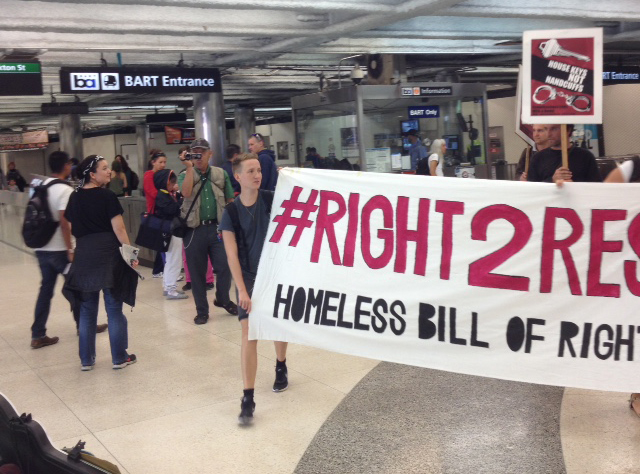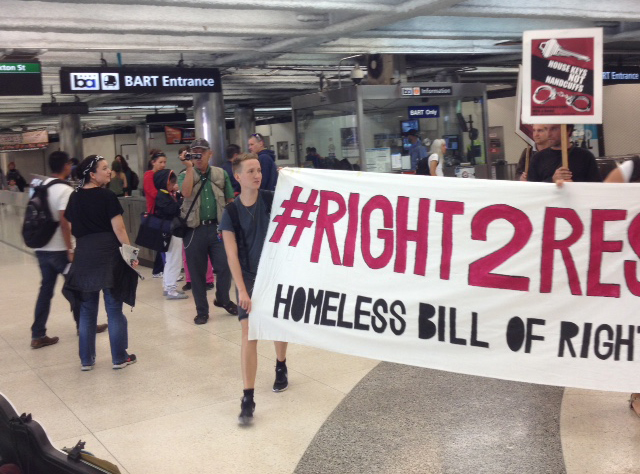
 Activists protest BART police policy, which authorizes arresting homeless persons sleeping against station walls. (Photo: Andrew Klein)
Activists protest BART police policy, which authorizes arresting homeless persons sleeping against station walls. (Photo: Andrew Klein)
San Francisco homeless advocates are challenging a policy, implemented in July 2014, authorizing the police force of the Bay Area Rapid Transit system to arrest individuals resting or sleeping against BART station walls.
The names of the five individuals shot and killed by police officers of the Bay Area Rapid Transit system (BART) emanated from a bullhorn at a recent San Francisco rally, protesting BART’s treatment of the city’s homeless. For the activists lining the walls of the Powell Street BART Station on this Saturday morning in November, the BART police shootings underscored the injustice of an institution, which, for its detractors, has become synonymous with racial profiling, police brutality and abuse of power.
The rally, which its organizers labeled a “sleep-in,” centered on a policy ratified in July 2014, which allows BART police to arrest or issue citations to anyone resting or sleeping against the walls of BART stations. Those in attendance were aiming to reverse that specific policy, but they located their campaign within a broader effort to both reform the conduct of BART police and combat the general marginalization of San Francisco’s poor.
“This is definitely an action in and amongst a larger fight for San Francisco and a fight for justice for people of color and poor people and homeless people,” said Lisa Marie Alatorre, a human rights organizer with the Coalition on Homelessness and one of the organizers of the sleep-in. “We are definitely doing this action in solidarity with the folks who are fighting for justice for Oscar Grant.”
BART’s Legacy of Repression
On New Year’s Day in 2009, BART officer Johannes Mehserle shot and killed Grant, a young African-American man, while he was lying facedown and handcuffed on the Fruitvale station platform. The Grant killing was captured on smart phone cameras and its story inspired a critically acclaimed film, contributing to its reputation as the most notorious instance of BART police misconduct.
In the wake of the incident, the city of Oakland saw a wave of peaceful protests. Some rioting also occurred both after the shooting and after Mehserle’s conviction of involuntary manslaughter, a verdict far milder than desired by much of Grant’s East Bay community. Police responded to the unrest with tear gas and rubber bullets.
A similar course of events would soon follow. In July 2011, Charles Hill, a homeless man suffering from mental illness, became another name on the list of people shot and killed by BART police officers. With public outrage mounting in the weeks after his death, BART made the unprecedented decision to shut down cell phone service in several stations in advance of a protest and memorial for Hill.
The move was widely condemned. The Electronic Frontier Foundation, a civil liberties advocacy group focusing on digital issues, compared the decision to actions taken by ousted Egyptian dictator Hosni Mubarak during the final days of his rule.
Criminalizing Homelessness
Now, community anger with BART police is focusing on its policies toward the homeless – a population comprised disproportionately of people of color and the mentally ill.
In July 2014, BART unveiled a measure, supposedly based on a set of preexisting but unenforced laws, prohibiting lying down in stations. The measure resembles the sit/lie ordinance implemented in San Francisco in 2010, which forbids sitting or lying on a public sidewalk during the daytime.
Activists say the BART measure, like the sit/lie law, discriminates against the city’s most vulnerable and fails to address the root causes of homelessness. Bilal Ali, a longtime organizer and human rights activist in Los Angeles and San Francisco, described the BART policy as “harassment.” “People who are already surviving on the precipice of existence are now having their existence threatened by being denied basic life sustaining activities, such as sleeping and resting,” Ali said, while taking a break from leading chants at the sleep-in.
But Tyrone Forte, a BART police lieutenant, sees the issue differently. He called the measure a safety precaution and one that was enacted in full accordance with the law. “We want to keep these routes clear, so that people – our patrons and our employees – can come through these stations in a safe manner and evacuate in a safe manner,” said Forte, who was among a detail of BART officers supervising the protest. “So, since July, we have enforced the building code to keep these areas clear.”
Both the American Civil Liberties Union and the Lawyer’s Committee on Civil Rights have contested the legitimacy of that building code, which BART cites as the legal justification for arresting or citing individuals lying down in stations. In a letter to BART officials, the groups examined the provisions from the California penal code and the San Francisco municipal code, which the BART administration uses as a basis for clearing the homeless from station corridors.
Its authors concluded that, “neither of these laws make it illegal to lie down and/or sleep in a station.” They also took issue with the claim that enforcing these laws is a matter of safety, noting, “In the wide passageways of these downtown stations, someone who is positioned against or near a wall is not obstructing, much less willfully obstructing, even if they are occupying some portion of BART property.”
Lack of Shelter
One byproduct of this debate has been increased attention to the level of resources allocated to San Francisco’s homeless.
Forte of BART police described his agency as sensitive to the needs of the homeless, insisting that BART’s strategy for dealing with this population was not strictly a punitive one. “What we also do to those who are laying down in violation is that we give them service referrals,” Forte said, stressing the fact that BART officers work with a full-time crisis intervention consultant and a homeless outreach team to match the homeless with resources. “In some cases we have found shelter for them, if they want it.”
But activists characterize such statements as a public relations ploy. They say that homeless people gravitate to BART stations, not because they prefer their accommodations, but because there simply is not enough space in shelters to house them.
“The services that BART police are saying that they are trying to get people connected with just don’t exist,” said Alatorre of the Coalition on Homelessness. A recent study indicates there are around five times as many homeless people living in San Francisco as there are beds in shelters. Moreover, the number of unsheltered homeless individuals living in the city has been on the rise in recent years, with families frequently spending months on the waiting list before being admitted.
Cold or Jail
These facts lend credence to activists’ reports that the choice between sleeping in the cold or sleeping somewhere warm and potentially going to jail is one that thousands face on a daily basis in San Francisco.
Homeless individuals affected by the BART policy also testify to this reality. Benetta Ardion, a homeless woman living in downtown San Francisco, said the new BART measure has not deterred her from attempting to sleep in the Powell Street BART station.
She described a recent case, in which BART police woke her up with shouting and physically forced her to leave the station. “The other morning they wake me up. ‘It’s time to leave. Get up! Get up! BART police!'” Ardion recalled. With shelters near capacity, BART stations are the safest and warmest option for a night’s rest, she said.
But choosing to sleep inside stations comes with the risk of detention or arrest. For violating the no sleeping policy, Ardion has spent time in a holding cell hidden inside the Powell Street station, which BART critics describe as “a cage.”
Without a viable housing option, the threat of being locked up is not an effective way of discouraging the homeless from sleeping in BART stations, said Bilal Ali, as he slumped against a wall in the Powell Street station during the sleep-in protest. “We do not need more harassment, more people going to jail because they have no other place to sleep or rest,” he said. “We need housing and we need policies to reflect that in this city.”
Join us in defending the truth before it’s too late
The future of independent journalism is uncertain, and the consequences of losing it are too grave to ignore. To ensure Truthout remains safe, strong, and free, we need to raise $24,000 by the end of today. Every dollar raised goes directly toward the costs of producing news you can trust.
Please give what you can — because by supporting us with a tax-deductible donation, you’re not just preserving a source of news, you’re helping to safeguard what’s left of our democracy.